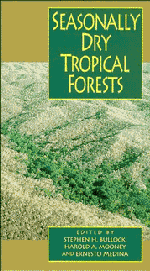Book contents
- Frontmatter
- Contents
- List of contributors
- Acknowledgements
- 1 Introduction
- 2 Dry forests of Central America and the Caribbean
- 3 Overview of the Brazilian caatinga
- 4 Savannas, woodlands and dry forests in Africa
- 5 Dry forest ecosystems of Thailand
- 6 The Cenozoic record of tropical dry forest in northern Latin America and the southern United States
- 7 Diversity and floristic composition of neotropical dry forests
- 8 Vertebrate diversity, ecology and conservation in neotropical dry forests
- 9 Diversity of life forms of higher plants in neotropical dry forests
- 10 Drought responses of neotropical dry forest trees
- 11 Plant reproduction in neotropical dry forests
- 12 Plant–herbivore interactions in Mesoamerican tropical dry forests
- 13 Biomass distribution and primary productivity of tropical dry forests
- 14 Nutrient cycling in tropical deciduous forests
- 15 Biology of the belowground system of tropical dry forests
- 16 Nitrogen trace gas emissions in a tropical dry forest ecosystem
- 17 Conversion of tropical dry forest to pasture and agriculture
- 18 Ethnobotany of the Mexican tropical dry forests
- Index
10 - Drought responses of neotropical dry forest trees
Published online by Cambridge University Press: 07 September 2010
- Frontmatter
- Contents
- List of contributors
- Acknowledgements
- 1 Introduction
- 2 Dry forests of Central America and the Caribbean
- 3 Overview of the Brazilian caatinga
- 4 Savannas, woodlands and dry forests in Africa
- 5 Dry forest ecosystems of Thailand
- 6 The Cenozoic record of tropical dry forest in northern Latin America and the southern United States
- 7 Diversity and floristic composition of neotropical dry forests
- 8 Vertebrate diversity, ecology and conservation in neotropical dry forests
- 9 Diversity of life forms of higher plants in neotropical dry forests
- 10 Drought responses of neotropical dry forest trees
- 11 Plant reproduction in neotropical dry forests
- 12 Plant–herbivore interactions in Mesoamerican tropical dry forests
- 13 Biomass distribution and primary productivity of tropical dry forests
- 14 Nutrient cycling in tropical deciduous forests
- 15 Biology of the belowground system of tropical dry forests
- 16 Nitrogen trace gas emissions in a tropical dry forest ecosystem
- 17 Conversion of tropical dry forest to pasture and agriculture
- 18 Ethnobotany of the Mexican tropical dry forests
- Index
Summary
Introduction
Many neotropical dry forests are dominated by trees that shed their foliage and remain leafless for a substantial period each year. Because the majority of deciduous species drop their leaves during the dry season and renew their canopies with the onset of the rains, the question of how these trees cope with seasonal reductions in soil moisture and increases in evaporative demand is most simply answered by calling them ‘drought avoiders’ (sensu Levitt, 1972). This categorization, however, gives little insight into the conditions, constraints and consequences that accompany the deciduous habit in these forests. Furthermore, the coexistence of even a small number of evergreen species indicates that the deciduous habit is not unconditionally imposed by the environment and that patterns of leaf fall and renewal must be viewed as part of an integrated response to environmental conditions. Seasonality in water availability clearly plays a major role in structuring patterns of activity and growth in this biome, but there have been few studies of the dominant life form (and fewer of life-form diversity; see Medina, Chapter 9). In this chapter, we address characteristics of trees of tropical dry and deciduous forests that influence their patterns of water use.
Plants respond to changes in resource availability on several scales. Our review considers three such levels: ‘structure’ encompasses features that remain relatively constant throughout the life of a plant, such as rooting patterns or stem hydraulic properties; ‘physiology’ focuses on parameters that influence diurnal patterns of water use and gas exchange; while ‘phenology’ considers seasonal patterns of meristem activity.
- Type
- Chapter
- Information
- Seasonally Dry Tropical Forests , pp. 243 - 276Publisher: Cambridge University PressPrint publication year: 1995
- 86
- Cited by



